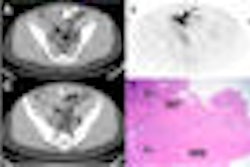Changes in standardized uptake values (SUVs) on FDG-PET/CT scans may be "significantly predictive of tumor recurrence" in patients with squamous cell cancer of the neck and head, according to a new study from Wake Forest University School of Medicine in Winston-Salem, NC.
Based on those SUV changes, the researchers theorized that therapy and treatment could be tailored to patients to improve outcomes. The study was outlined by lead author Dr. Kathryn Greven, professor of radiation oncology at Wake Forest, at the annual meeting of the American Society for Radiation Oncology (ASTRO) in Chicago this month.
"Some head and neck cancers respond very well to treatment and are cured, and some are not," Greven said. "We were interested to know whether PET scans could help predict which patients might respond better by scanning them early in the course of treatment."
The study prospectively enrolled 16 patients between March 2006 and July 2007 to evaluate the role of FDG-PET/CT for stage III or IV node-positive head and neck cancer.
Tumor progression
All 16 patients were treated with chemoradiation and received five FDG-PET/CT scans at initiation of therapy, two and four weeks after the start of chemoradiation, and again at three weeks and six months after completion of treatment. One patient did not receive a scan after two weeks from the start of chemoradiation, while two other patients were not scanned four weeks after the initiation of chemoradiation.
Researchers recorded the maximum SUVs in the primary tumors and used CT to measure their maximum dimensions.
In following up patients at 15 to 30 months, the study found that three patients had a recurrence of cancer at the primary tumor site. Twelve patients had decreasing SUVs two weeks after initiation of chemoradiation, while one patient remained the same and two patients experienced increased SUVs. The changes in SUV ranged from a decrease of 75% to an increase of 21% compared to the initial scan.
The study also found that all 16 patients had stable or decreasing SUVs four to six weeks after initiation of therapy. Three months after completion of chemoradiation, the maximum SUV increased by 40% for one patient, while remaining at or below baseline levels for all other patients.
SUV comparison
For the three patients who had a recurrence of their tumor and the 13 patients who remained disease-free, the researchers compared the change in SUV from the baseline numbers at four points: two weeks and four weeks later, at postradiation therapy at six weeks, and at three months.
Changes in SUV uptake
|
Based on the numbers, the researchers concluded that higher SUVs were significantly associated with a risk of recurrence (p = 0.04).
"It was amazing to me that patients had such a dramatic response on their FDG uptake with just two weeks of radiation and chemotherapy. Some of them were completely responsive when we did their first PET scan," Greven said. "By four weeks, almost everyone had responded, but then you start seeing changes after completion" of treatment.
With contrast-enhanced CT, the researchers took primary tumor measurements at the four follow-up points and found that the numbers steadily decreased for patients with local cancer recurrence and those who were disease-free.
Contrast-enhanced CT: Primary tumor measurement changes
|
Based on the results, the authors determined that CT measurements were not associated with the risk of recurrence.
The study concluded that changes in SUV from FDG-PET/CT were "significantly predictive of tumor recurrence compared to CT imaging alone."
While the results are encouraging, Greven emphasized that a larger patient study is needed to formulate more definitive conclusions. "It looks promising, but there were only three bad responders and 13 good responders. I think you have to be cautious whenever you get information like that," she said. "It is possible that getting a PET scan early in the course of radiation may help to direct therapy for these patients, but I can't say anything more definitive than that."
Currently, there are no plans to extend the research in this area. A follow-up study, Greven said, would depend, in part, on funding.
By Wayne Forrest
AuntMinnie.com staff writer
November 20, 2009
Related Reading
Fluoride ion FDG-PET/CT beats FDG for metastatic spinal bone lesions, November 3, 2009
FDG-PET/CT scans spot head and neck cancer return October 14, 2009
FDG-PET/CT helps track pediatric bone and soft-tissue tumors, June 16, 2009
FDG-PET/CT shows early chemo results, April 16, 2009
FDG-PET/CT reveals occult metastasis of head and neck cancer, September 7, 2007
Copyright © 2009 AuntMinnie.com




















